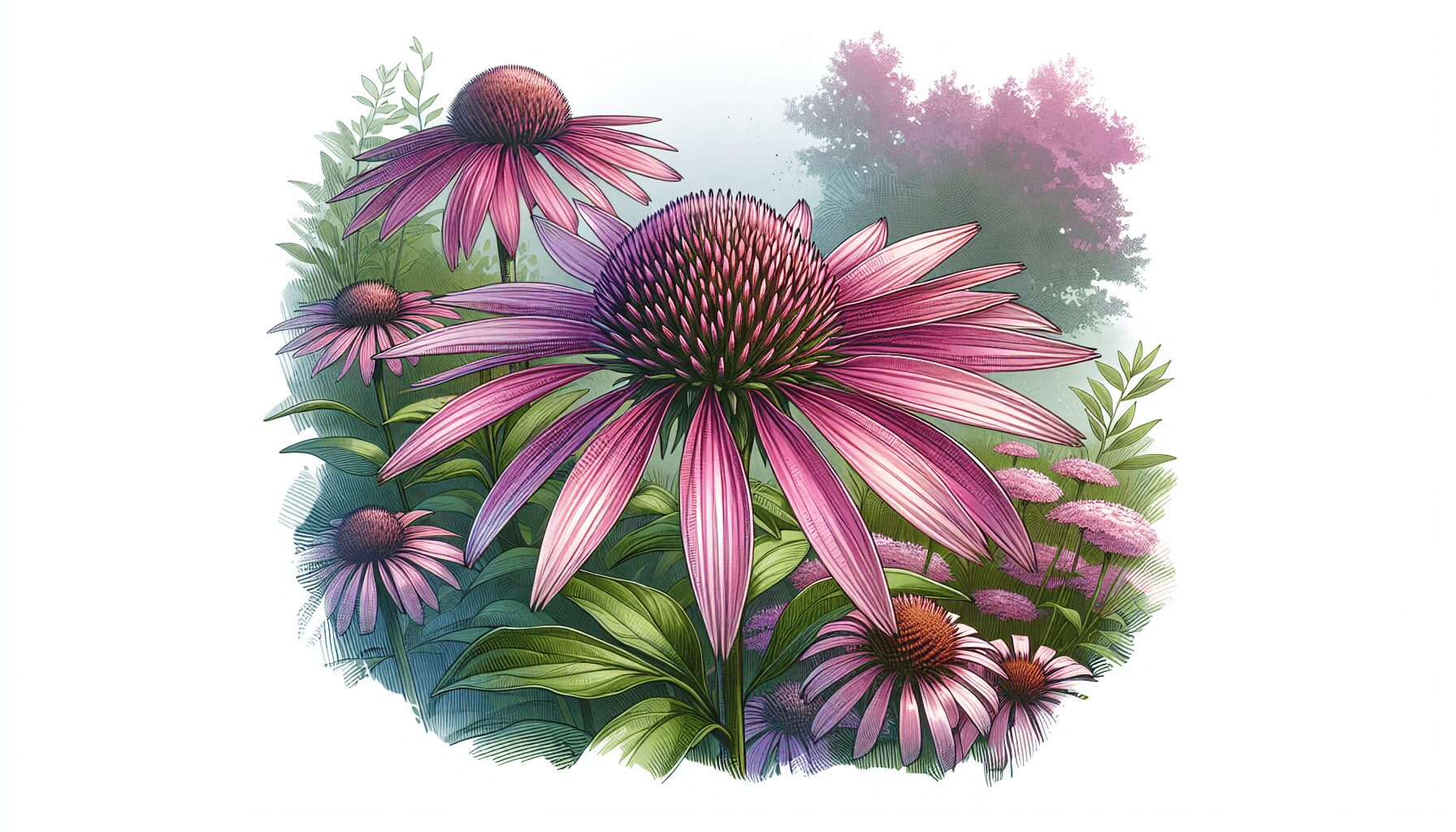Echinacea for Immune Health – How Does it Work? explores the fascinating world of one of the most popular herbs used for bolstering the immune system and preventing colds and flu. You’ll learn about the different varieties of echinacea, their distinct characteristics, and how they are used in herbal medicine. This guide also sheds light on the intricate mechanisms through which echinacea helps stimulate the immune response and offers practical tips for harvesting and preparing the herb.
Whether you’re a seasoned herbalist or just curious about natural remedies, this article provides an engaging and educational look at echinacea’s role in immune health. From its stunning flowers that attract pollinators to its potent roots that fortify the body against infections, you’ll discover why echinacea has been cherished for centuries. Join in as we unravel the secrets of this remarkable plant and uncover its potential benefits for your well-being.

This image is property of i.ytimg.com.
What is Echinacea?
Echinacea, often known as coneflower, is a group of herbaceous flowering plants in the daisy family. This plant is widely recognized in the wellness world, especially for its reputed immune-boosting properties.
Overview of Echinacea
Echinacea consists of several species native to North America, most commonly found in prairies and open woodlands. These perennial plants are known for their striking, daisy-like flowers that bloom in the summer. The name “Echinacea” is derived from the Greek word “echinos,” meaning hedgehog, referring to the spiny nature of the flower’s central cone. Besides its visual appeal, Echinacea is celebrated for its potential health benefits, especially in supporting the immune system.
Historical Use in Herbal Medicine
Historically, Echinacea has been used by Native American tribes for centuries. They utilized various parts of the plant, including the roots, leaves, and flowers, to treat infections and wounds, reduce sore throats, and alleviate pain. As European settlers learned about these traditional remedies, Echinacea became a staple in herbal medicine. By the 20th century, it gained popularity in Europe and eventually worldwide, particularly for preventing and treating the common cold and flu.
Popular Varieties
Among the multiple species of Echinacea, three are most often used for medicinal purposes:
- Echinacea purpurea
- Echinacea angustifolia
- Echinacea pallida Echinacea purpurea is the most commonly cultivated and studied variety, known for its vibrant purple flowers and easy growth habits. Echinacea angustifolia, with narrower leaves and more cold-hardy characteristics, is often considered more potent by herbalists. Echinacea pallida, while less common, also boasts beneficial properties.
Types of Echinacea Used in Medicine
Among the various species, Echinacea purpurea and Echinacea angustifolia are the most frequently utilized in medicinal preparations.
Echinacea Purpurea
Echinacea purpurea, or purple coneflower, is the tallest variety with hairless stems and large, showy flowers. This species is widely grown in herb gardens and used in numerous commercial herbal products. It is renowned for its robust immune-supporting qualities, making it a popular choice for boosting overall wellness and preventing colds.
Echinacea Angustifolia
Echinacea angustifolia, also known as narrow-leaf coneflower, features narrower leaves and smaller flower heads. It is more cold-hardy and has hairier stems compared to its purpurea cousin. This variety is often preferred by herbalists for its stronger antiviral properties, particularly in combating rhinoviruses, the common cold culprits.
Comparative Characteristics
While both Echinacea purpurea and Echinacea angustifolia are effective, they have distinct characteristics. Echinacea purpurea is easier to grow and more commonly found in commercial products. On the other hand, Echinacea angustifolia is often considered more effective for specific viral infections due to its concentrated bioactive compounds.
Bioactive Compounds in Echinacea
The health benefits of Echinacea are largely attributed to its rich array of bioactive compounds.
Alkamides
Alkamides are one of the primary active constituents in Echinacea, known for their immunomodulatory effects. They help stimulate the immune system by enhancing the activity of macrophages and promoting cytokine production, two crucial components in your body’s defense mechanism.
Polysaccharides
Polysaccharides in Echinacea play a significant role in activating the immune response. They enhance the production of interferon, an essential protein that inhibits viral replication and stimulates the activity of white blood cells. These complex carbohydrates are particularly concentrated in the roots and contribute to the plant’s antiviral properties.
Caffeic Acid Derivatives
Caffeic acid derivatives, such as echinacoside and chlorogenic acid, are powerful antioxidants found in Echinacea. They help neutralize free radicals, reducing oxidative stress and inflammation. These compounds also display antibacterial and antiviral activities, further supporting the plant’s medicinal benefits.
Mechanism of Immune Stimulation
Echinacea’s ability to bolster your immune system is multifaceted and involves several mechanisms.
Activation of White Blood Cells
Echinacea enhances the activity and proliferation of white blood cells (WBCs), particularly macrophages and natural killer (NK) cells. These cells are crucial for identifying and destroying pathogens, ensuring your body can respond swiftly and effectively to infections.
Virus-Fighting Properties
Compounds in Echinacea can interfere with viral replication. For example, Echinacea angustifolia has been shown to inhibit the binding of certain viruses, such as rhinovirus and influenza, to your cell receptors, preventing them from infecting healthy cells.
Impact on Mucus Membranes
Echinacea helps strengthen mucus membranes, the body’s first line of defense against pathogens. By promoting hyaluronan inhibition, Echinacea fortifies these protective barriers, making it more challenging for viruses to penetrate and establish infections.

Scientific Evidence and Studies
The therapeutic potential of Echinacea has been investigated in numerous studies, with mixed but generally positive results.
Research Supporting Immune Benefits
Several studies suggest that Echinacea can reduce the duration and severity of cold symptoms. For instance, a 2014 meta-analysis concluded that Echinacea extracts can decrease the incidence of colds by 10-20%.
Clinical Trials and Findings
Clinical trials have produced varied results. While some studies have confirmed Echinacea’s efficacy in shortening cold duration and alleviating symptoms, others have found no significant benefits. Variability in study designs, dosages, and Echinacea preparations often contribute to these inconsistent results.
Debates and Contradictions
Despite its popularity, Echinacea remains controversial in scientific circles. Critics argue that many studies are flawed, with small sample sizes and inconsistent methodologies. Moreover, the exact species, part of the plant, and preparation method can considerably impact the outcomes.
Forms and Preparations
Echinacea is available in various forms, each with its advantages and uses.
Tinctures
Tinctures are liquid extracts typically made by soaking Echinacea in alcohol to draw out the active compounds. They are concentrated and easy to dose, making them a popular choice for quick immune support.
Teas and Infusions
Echinacea teas are made by steeping dried leaves, flowers, or roots in hot water. This preparation is soothing and provides a gentle, prolonged delivery of Echinacea’s benefits. Teas are often combined with other herbs to enhance flavor and efficacy.
Capsules and Tablets
For those who prefer convenience, Echinacea is also available in capsule or tablet form. These preparations provide a standardized dose and are easy to incorporate into your daily supplement routine.

Echinacea in Commercial Products
Echinacea’s popularity has led to its inclusion in many commercial herbal products.
Common Brands and Products
Brands like Yogi Tea and Traditional Medicinals offer Echinacea teas, while supplement companies produce various Echinacea capsules, tinctures, and extracts. These products are widely available in health food stores and online.
Quality and Potency Considerations
When choosing an Echinacea product, quality and potency are crucial. It’s essential to select products made from reputable brands that use high-quality, organically grown Echinacea. Check for labels indicating standardization of active ingredients to ensure you’re getting a potent product.
Specialized vs. General Formulations
Some products combine Echinacea with other herbs or vitamins to enhance its immune-boosting effects. While general formulations can be effective, specialized blends may target specific health needs, such as cold and flu relief or overall immune support.
Potential Side Effects and Precautions
Although Echinacea is generally safe for most people, there are a few considerations to keep in mind.
Common Side Effects
Some individuals may experience mild side effects such as digestive upset, rash, or dizziness. These reactions are typically short-lived and resolve on their own.
Interactions with Other Medications
Echinacea can interact with certain medications, including immunosuppressants and some anti-anxiety drugs. If you are taking prescription medications, it’s important to consult your healthcare provider before starting Echinacea.
Cautions for Autoimmune Conditions
People with autoimmune disorders should exercise caution when using Echinacea, as its immune-stimulating properties could potentially trigger flare-ups or exacerbate symptoms. Always consult your doctor before use if you have an autoimmune condition.
How to Grow and Harvest Echinacea
Growing Echinacea in your garden can be a rewarding way to ensure a fresh supply of this beneficial herb.
Seed Collection and Planting
Collect seeds from mature Echinacea flowers in the fall. Stratify the seeds by placing them in the refrigerator for about 30 days before planting. Sow the seeds in well-draining soil, either indoors or directly in the garden, after the last frost.
Caring for Echinacea Plants
Echinacea plants thrive in full sun and well-drained soil. Water them regularly during their first growing season to help them establish strong roots. Once mature, Echinacea is drought-tolerant and requires minimal care.
When and How to Harvest
Harvest Echinacea leaves and flowers during the blooming season, typically mid-summer. Roots should be harvested in the fall after the plant has finished flowering. Use a fork or spade to gently lift the roots from the soil, taking care to preserve their structure.
Conclusion
Summary of Benefits
Echinacea is a remarkable herb with a storied history and multifaceted health benefits. Known for its immune-boosting properties, it can aid in preventing and treating colds, support white blood cell activity, and strengthen mucus membranes. The plant’s bioactive compounds, including alkamides, polysaccharides, and caffeic acid derivatives, contribute to its efficacy.
Final Thoughts and Recommendations
Whether you’re an experienced herbalist or a beginner in natural remedies, Echinacea is a valuable addition to your wellness toolkit. It’s accessible in various forms, from tinctures and teas to capsules, allowing for flexible integration into your routine. However, always consider quality, potency, and any personal health conditions before use. With proper care, you can even grow and harvest your Echinacea, ensuring a constant supply of this incredible herb.